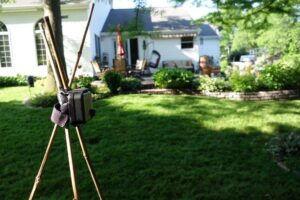SLU Biodiversity Research Update
Billiken Bee Lab
Published in the December 2020 Tale Feathers Newsletter
In 2019, St. Louis Audubon began a partnership with Dr. Gerardo Camilo at Saint Louis University and the researchers in his Billiken Bee Lab. Dr. Sacha Heath, Nina Fogel and Trey Hull are investigating factors that influence biodiversity within home landscapes and neighborhoods by surveying homes enrolled in our own Bring Conservation Home (BCH) program. (See more program information.)
For the bird component of the study, Sacha Heath and BCH participants deployed an AudioMoth bioacoustic recording device (pictured above) in each of 63 Bring Conservation Home yards (21 triplets of 3 BCH certification types (no certification, Silver, Gold/Platinum) along the urbanization gradient). The recording devices recorded 1 minute clips every 10 minutes from 2 hours before dusk through 3 hours after dawn, for a total of 177,193 1-minute clips, and 1 TB of data! Over the next year, Sacha will be using a combination of machine learning and automatic identification techniques to compile these data, identify birds from the sound clips, and analyze the data to answer her questions about the effects of urbanization and local yard-scale conservation efforts.
Nina Fogel sought to investigate bee diversity in 65 BCH yards. She had 16 triplets of 3 BCH certification types (no certification, Silver, Gold/Platinum) that corresponded with Sacha’s yards and 17 additional Silver houses. She sampled bee diversity in each house once a month, June through August. Additionally, she recorded the flowering plants in bloom at every visit. She caught around 3500 bees over the course of the summer, representing roughly 33 of the 45 genera that have been found in St. Louis. Over the next few months Nina will identify the bees to species level. With that information she intends to begin investigating how the level of urbanization and the floral diversity within the yard correspond to bee diversity. For the next two summers Nina hopes to narrow her focus and do more sampling in a subset of yards, specifically ones that have an intermediate level of plant diversity (often Silver certification level but not always).
This summer Trey Hull began researching different aspects of urban mosquito ecology and biodiversity in 45 BCH yards (15 triplets in 3 BCH certification types (no certification, Silver, Gold/Platinum) along the urbanization gradient). Over the course of the summer Trey collected an estimated 6,000 mosquitoes from at least 3 genera. And even though this collecting season is complete, Trey’s work is far from over. For the next several months, Trey will be working on completing the counting and identification of each mosquito. Once that is done, Trey can begin analyzing the data for critical insight into how biodiversity and land use may affect mosquitoes and where they live.
Pictures: Nina Fogel in the lab and, the AudioMoth Bioacoustic Recording Device






